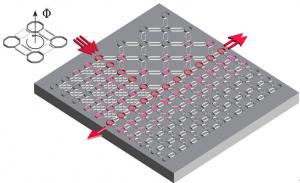Long-range-interacting topological photonic lattices breaking channel-bandwidth limit
GA, UNITED STATES, September 4, 2024 /EINPresswire.com/ -- Optical phenomena are typically modeled with nearby interactions because interactions between optical elements generally decrease rapidly with distance. In the research from the Republic of Korea, scientists explored the impact of significant long-range interactions in topological photonics. Their design surpasses the traditional channel-bandwidth constraints in topological photonic devices. This result sets the stage for extending topological phenomena into network science.
Topological physics, which focuses on physical quantities that remain invariant under deformations, has garnered widespread interest in different areas of physics—photonics, quantum computing, solid-state physics, acoustics, and electronic circuits—due to its potential for noise-immune computation and signal processing. In the field of photonic integrated circuits, which aims to perform computations by tailoring light flows, there has been a concentrated effort over the past decade to implement noise-resistant signal processing using topologically protected light states.
One of the major challenges in the practical implementation of this research direction is overcoming the bandwidth limitations of signal processing. When implementing topological properties using neighboring interactions between optical elements of a two-dimensional system, there exists a trade-off relation between the number of signal channels and the channel bandwidth determined by the lattice bandgap. This trade-off prohibits increasing the total information capacity (= channels × bandwidth).
In a new paper (https://doi.org/10.1038/s41377-024-01557-4) published in Light: Science & Applications, a team of scientists, led by Professor Sunkyu Yu and Professor Namkyoo Park in the Department of Electrical and Computer Engineering at Seoul National University, Korea, and co-workers have implemented a defect-robust multi-channel signal processor by tailoring long-range interactions in topological photonic lattices. Unlike conventional topological systems that rely solely on nearest-neighbor interactions, the researchers’ system employs hardware that allows for substantial long-range interactions, which enable the effective overlap of conventional lattice structures within the two-dimensional plane. This “lattice overlap” technique provides the tailoring of topological invariants—here, “the Chern numbers”—while preserving the bandgap of an original lattice. This tunable Chern number offers multichannel topologically-protected edge modes, eventually breaking the trade-off relation between the number of signal channels and the channel bandwidth.
In the paper, the scientists implemented their lattice overlap strategy in the famous Hofstadter model using system parameters available in conventional silicon photonics, which they analyzed with Tidy3D software. They demonstrated the incoherent optical functionality—multichannel wave splitter for light with random phases and amplitudes—which is highly robust to various types of disorder. The result shows that their approach enables noise-immune signal processing with enhanced information capacity. These scientists summarize their design strategy:
“Previously, topological photonic circuits have been implemented typically under the condition of nearest-neighbor interactions between optical elements. Although some efforts have been conducted to analyze the effect of long-range interactions, these interactions were assumed to be much weaker than neighboring ones due to the nature of electromagnetic waves. In our work, we design integrated photonic platforms that can achieve long-range interactions stronger than neighboring ones. This approach allows for the implementation of the ‘lattice overlap’ design, effectively realizing the multiple overlap of the conventional lattices within a two-dimensional plane.”
“This overlapped lattice provides the design freedom for achieving arbitrary Chern number while preserving the bandgap width. We demonstrated the result with the Hofstadter model example. The obtained Chern-number manipulation allows for multichannel topologically-protected edge modes in the wide bandgap, which resolves the channel bandwidth issue. Our result therefore enables robust and high-capacity signal processing in photonic integrated circuits, which have been widely employed in AI accelerators and quantum computing.”
“Long-range interactions partially emulate higher-dimensional physics as shown in the increased coupling degrees at each node. Therefore, fundamentally, we believe the most significant impact of our research would be the effective modelling of higher-dimensional physics on a two-dimensional plane. This breakthrough could pave the way for implementing topological phenomena in complex networks, which is one of the ultimate goals of our research”.
DOI
10.1038/s41377-024-01557-4
Original Source URL
https://doi.org/10.1038/s41377-024-01557-4
Funding information
We acknowledge financial support from the National Research Foundation of Korea (NRF) through the Basic Research Laboratory (No. RS-2024-00397664), Young Researcher Program (No. 2021R1C1C1005031) and Mid-career Researcher Program (No. RS-2023-00274348), all funded by the Korean government. This work was supported by Creative-Pioneering Researchers Program and the BK21 FOUR program of the Education and Research Program for Future ICT Pioneers in 2023, through Seoul National University. We also acknowledge an administrative support from SOFT foundry institute.
Lucy Wang
BioDesign Research
email us here
Legal Disclaimer:
EIN Presswire provides this news content "as is" without warranty of any kind. We do not accept any responsibility or liability for the accuracy, content, images, videos, licenses, completeness, legality, or reliability of the information contained in this article. If you have any complaints or copyright issues related to this article, kindly contact the author above.

